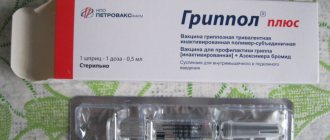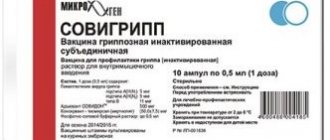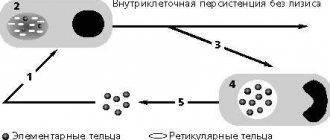Indications for use
- Influenza prevention is recommended for adults and children over 6 months of age who are at increased risk:
- persons over 60 years old
- patients with chronic somatic diseases, diseases of the cardiovascular system, chronic renal failure, metabolic disorders (including diabetes), cystic fibrosis, chronic respiratory diseases, often suffering from acute respiratory infections, as well as congenital and acquired immunodeficiencies
- preschool children, schoolchildren
- persons at increased risk of influenza infection due to the nature of their work
What is included in the Ultrix Quadri vaccine?
The exact composition of antigens, like other influenza vaccines, is updated annually in accordance with WHO recommendations. The dosage of each is at least 15 mcg, which is recommended by WHO. In addition to them directly, the drug contains only 3 components: polysorbate 80, widely used in the food industry as an emulsifier, octoxynol 10 as a stabilizer and phosphate buffer solution. Ultrix Quadri does not contain additional immune response enhancers, for which some other domestic drugs have been repeatedly criticized.
Additional Information
Is it possible to purchase Ultrix from us or where to buy Ultrix in Moscow?
The City of Childhood clinic on Taganka and Zhulebino does not sell the Ultrix vaccine, we vaccinate.
Where to get the Ultrix vaccination in Moscow?
You can get vaccinated with Ultrix at the City of Childhood clinic on Taganka and Zhulebino, the Ultrix vaccine is available. Vaccination requires a mandatory examination before vaccination, the vaccination itself and observation after vaccination.
Call us, we will tell you everything in more detail
PricesSpecialistsSign upContacts
| Examination before vaccination | |
| Examination by a doctor before vaccination | 1600 |
| Name of service | |
| Vaxigrip - flu vaccination | 1000 |
| Influvac - flu vaccination | 1000 |
| Ultrix - flu vaccination | 1000 |
| Ultrix Quadri - flu vaccination | 1000 |
Call us, we will tell you everything in more detail
What is known about Ultrix Quadri?
This is an inactivated split vaccine containing antigens of influenza virus types A (H1N1 and H3N2) and B (Yamagata and Victoria lines). Thus, unlike the regular Ultrix, it is four-part. Vaccines of this type appeared in Russia 2 years ago, in 2021. They are considered more effective (as they protect against more varieties of influenza), but production capacity was initially sufficient only for risk groups (people with severe chronic diseases), so they became available to a wide range of patients relatively recently. It is now rated as one of the most reliable flu shots available to Russians. The vaccine was created by the Rostec state corporation.
Our doctors
Pastushnaya Victoria Sergeevna
Pediatrician, Chief Physician, Expert, Vaccine Prevention
Gammel Elizaveta Nikolaevna
Pediatrician, Vaccine prevention, Gastroenterologist, Functional diagnostics (Taganka, Zhulebino)
Ilyina Larisa Anatolyevna
Pediatrician, Vaccine prevention (Zhulebino)
Konovalova Elena Borisovna
Pediatrician, Vaccine prevention (Zhulebino)
Filippov Andrey Nikolaevich
Pediatrician, Vaccine prevention (Taganka)
Leave a request
we will find a convenient time for you
special instructions
On the day of vaccination, those vaccinated must be examined by a doctor (paramedic) with mandatory thermometry. At temperatures above 37.0°C, vaccination is not carried out. The vaccinated person should be under the supervision of a health care worker for 30 minutes after immunization. The Ultrix vaccine does not affect the ability to drive a car or control machines and mechanisms.
Come get vaccinated at MiracleChildren. A full range of vaccines for children and adults, family vaccinations - at a special price!
Possible side effects
Systemic reactions: possible - slight short-term increase in body temperature, fever, general malaise (these phenomena resolve on their own within 1-2 days); extremely rarely - neuralgia, paresthesia, convulsions, transient thrombocytopenia, neurological disorders, vasculitis.
Allergic reactions: in patients with known sensitivity to individual components of the vaccine - itching, urticaria, rash; extremely rare - severe allergic reactions such as anaphylactic shock.
Local reactions: soreness, redness and swelling at the site of vaccine administration. These adverse reactions develop on the day of vaccination, usually go away on their own within 1-3 days and do not require treatment.
INSTRUCTIONSon the use of a medicinal product for medical use
Ultrix®
Inactivated split influenza vaccine
Trade name: Ultrix®.
Group name: Vaccine for the prevention of influenza
[inactivated].
Dosage form: solution for intramuscular administration.
Compound. The vaccine is a mixture of highly purified protective surface and internal antigens of influenza viruses type A (H1N1 and H3N2) and type B in a phosphate-buffered saline solution*.
1 dose (0.5 ml) contains influenza viruses cultured on chicken
embryos, inactivated, split, represented by strains,
equivalent to the following:
| A/Michigan/45/2015 (H1N1) pdm09 | — | (15±2.2) µg GA; |
| A/Hong Kong/4801/2014 (H3N2) | — | (15±2.2) µg GA; |
| B/Brisbane/60/2008 | — | (15±2.2) µg GA. |
| Preservative – merthiolate – from 85 to 115 | mcg/ml or does not contain a preservative. | |
* Note: composition of phosphate-buffered saline solution: sodium chloride;
disodium hydrogen phosphate, dihydrate; sodium dihydrogen phosphate; water for injections. The antigenic composition of the vaccine changes every year in accordance with
epidemic situation and WHO recommendations.
Description. Opalescent colorless liquid.
Immunological properties. The vaccine forms high specific immunity against influenza types A and B. After vaccination, antibodies appear within 8-12 days, immunity lasts up to 12 months.
Pharmacotherapeutic group. MIBP vaccine.
ATX code: J07ВВ02.
Indications for use.
Active annual preventive immunization against seasonal influenza. Preservative-free vaccine - children from 6 months of age, adolescents,
adults without age limit, women in the II-III trimesters of pregnancy; vaccine
with a preservative - adults over 18 years of age. The vaccine is especially indicated:
1
Persons whose occupation has a high risk of contracting influenza or infecting others with it:
- students;
- workers of medical and educational institutions, transport,
communal and social spheres, police, military personnel, etc.;
- students of educational institutions.
2. Persons at high risk of illness and complications from influenza:
- over 60 years old;
— often suffering from acute respiratory viral infections;
- suffering from chronic somatic diseases, including diseases and malformations of the cardiovascular, respiratory and central nervous systems, chronic kidney diseases, metabolic diseases,
diabetes mellitus, chronic anemia, allergic diseases (except allergy to chicken proteins); congenital or acquired immunodeficiency, including infection with the human immunodeficiency virus;
- pregnant women.
Vaccination is carried out annually in the autumn-winter period. Vaccination possible
at the beginning of the epidemic rise in the incidence of influenza.
Contraindications.
- allergic reactions to previous vaccinations with influenza vaccines;
— allergic reactions to chicken protein and vaccine components;
- acute febrile conditions or exacerbation of a chronic disease;
- pregnancy period (when using a vaccine with a preservative);
- age up to 18 years (when using a vaccine with a preservative);
- age up to 6 months.
For mild acute respiratory viral infections and acute intestinal diseases (vaccination is carried out after the body temperature of the vaccinated person has normalized), chronic diseases in the acute stage, vaccinations are carried out after recovery (remission).
Use during pregnancy and breastfeeding. Data from clinical studies of the vaccine involving women in the second and third trimesters of pregnancy showed that vaccination does not have a negative effect on the fetus
and the woman’s body and can be used during pregnancy. Vaccination with this drug can be carried out starting from the second trimester of pregnancy.
Experience with the use of inactivated influenza vaccines shows that
2
Vaccination of a woman during breastfeeding does not have a toxic effect on the child.
The final decision to vaccinate pregnant and breastfeeding women should be made individually by a physician, taking into account the risk of contracting influenza and possible complications caused by influenza.
When vaccinating pregnant women against influenza, vaccines that do not contain preservatives are used.
Method of administration and dose. The vaccine is administered intramuscularly only!
For children from 6 to 11 months, the vaccine is administered twice with an interval of 28 days into the anterolateral surface of the thigh in a dose of 0.25 ml (1/2 dose).
For children aged 12 to 35 months, the vaccine is administered twice with an interval of 28 days into the anterolateral thigh or deltoid muscle area at a dose of 0.25 ml (1/2 dose).
For children over 36 months, adolescents and adults without age restrictions, the vaccine is administered in a dose of 0.5 ml into the deltoid muscle area.
The drug is NOT SUITABLE for use in ampoules, vials or syringes with damaged integrity or markings, if the physical properties (color, transparency) have changed, if there are foreign particles in the solution, if the expiration date has expired, or if the requirements for storage conditions are violated.
Before vaccination, those vaccinated must be examined by a doctor (paramedic) with mandatory thermometry. If the body temperature is above 37 °C, vaccination is not carried out.
Rooms where vaccination is carried out must be equipped with anti-shock therapy. The vaccinated person should be under the supervision of a health care worker for 30 minutes after vaccination.
Rules for administering the Ultrix® vaccine:
1. Ampoules.
The vaccine should be kept at room temperature before use.
The ampoule should be shaken well before opening.
The opening of ampoules and the vaccination procedure are carried out in strict compliance with the rules of asepsis and antisepsis: before opening the ampoule knife/scarifier, the neck of the ampoule is wiped with cotton wool moistened with 70% ethyl alcohol, the ampoule is opened, the vaccine is drawn into a disposable syringe and the remaining air is removed from the syringe. The injection site is wiped with 70 percent alcohol.
The drug cannot be stored in an opened ampoule.
3
2. Bottles.
The vaccine should be kept at room temperature before use.
The bottle should be shaken well before opening.
The opening of the bottles and the vaccination procedure are carried out in strict compliance with the rules of asepsis and antiseptics.
Procedure for using a vial containing 1 dose of vaccine:
a) the bottle cap is treated with 70% ethyl alcohol using cotton wool, a cotton pad or a napkin;
b) the bottle is opened by removing the plastic colored cap or aluminum disk from its cap. Do not open the rubber stopper of the bottle!
c) the bottle stopper is treated with 70% alcohol;
d) the packaging of a sterile disposable syringe is opened, if necessary, a sterile needle is placed on the cannula of the syringe;
e) the needle is inserted into the rubber stopper of the bottle, the bottle is turned over and 0.25 or 0.5 ml of vaccine is drawn into the syringe;
f) the syringe is disconnected from the needle, leaving the needle in the stopper of the bottle;
g) a new sterile needle is put on the cannula of the syringe with one dose of vaccine, and the remaining air is removed from the syringe;
h) the injection site is wiped with 70% alcohol; i) the prepared vaccine is immediately administered to the patient.
A graduated syringe is used to withdraw ½ dose (0.25 ml). When taking 1 dose (0.5 ml), remove the entire contents of the bottle.
The remainder of the vaccine in the vial must be discarded immediately.
Procedure for using a vial containing 5 doses of vaccine:
To administer vaccine to a patient from a 5-dose vial, a new sterile syringe and sterile needle must be used each time.
Proceed as described above for a bottle containing 1 dose, except for point e):
f) the syringe is disconnected from the needle, leaving the needle in the stopper of the bottle, the bottle is covered with a sterile napkin, when taking subsequent doses of the vaccine, a new needle is not inserted into the bottle.
Once opened, the vaccine in a vial containing 5 doses must be used
for no more than 2 hours. The opened vial of vaccine is stored at room temperature under a sterile napkin. After two hours, the vial with the remaining vaccine is discarded.
4
3. Syringes.
Before use, the syringe with the vaccine should be kept at room temperature. Immediately before injection, the syringe should be shaken well.
Procedure for using a syringe without a safety device for pre-filled syringes:
Remove the protective cap from the syringe needle by carefully pulling it off the needle without twisting it away from the syringe. The remaining air is removed from the syringe.
The injection site is wiped with 70 percent alcohol. The vaccine is immediately administered to the patient. To do this, press the plunger, holding the syringe firmly, and inject its entire contents (1 dose).
If it is necessary to administer 1/2 dose (0.25 ml), half the contents are removed from a syringe containing 0.5 ml of the drug, bringing the plunger to the corresponding mark on the syringe. The remaining amount of vaccine (0.25 ml) is administered to the patient.
Procedure for using a syringe equipped with a safety device for pre-filled syringes:
To prevent the safety device from tripping:
— it is recommended to hold the syringe by the safety device, and not by the syringe plunger or needle cap, when removing it from the blister pack;
— before administering the drug, do not pull the safety device in the direction from the finger protrusions of the safety device towards the syringe needle;
- do not try to activate the safety device before the injection;
- do not attempt to remove the safety device from a pre-filled syringe before injection.
a) Before performing the injection, make sure that the safety device on the syringe is cocked and has not been triggered accidentally, i.e. the syringe needle in the cap is free and not covered with a safety device;
b) the cap is removed from the syringe needle by carefully pulling it from the needle without twisting in the direction from the syringe.
c) the injection site is wiped with 70% alcohol;
d) the vaccine is immediately administered to the patient. To do this, press the plunger, holding the syringe firmly, and inject its entire contents (1 dose). If it is necessary to administer 1/2 dose (0.25 ml), half the contents are removed from a syringe containing 0.5 ml of the drug, bringing the plunger to the corresponding mark on the syringe. The remaining amount of vaccine (0.25 ml) is administered to the patient.
5
e) after the injection, the safety device is activated. To do this, the safety device is pulled in the direction from the finger protrusions to the syringe needle to the maximum distance until a click occurs, which means that the safety device has worked. In this case, the syringe needle will be closed by a safety device.
Side effects. The information about adverse events given below was obtained from controlled clinical studies and during post-registration use of the drug in the Russian Federation.
Clinical trial data
In controlled clinical trials, the vaccine was administered to more than 5,000 vaccine recipients aged 18 and over and 100 vaccine recipients under the age of 18.
18 years.
The adverse events presented below are listed according to the damage to organs and organ systems and the frequency of occurrence. The frequency of occurrence is defined as follows: very common (>1/10), common (>1/100 and <1/10), uncommon (>1/1000 and <1/100), rare (>1/10000 and <1 /1000), very rare (< 1/10000, including isolated cases).
Nervous system disorders
Uncommon: headache*.
Skin and subcutaneous tissue disorders Uncommon: increased sweating*.
Musculoskeletal and connective tissue disorders Uncommon: arthralgia, myalgia*.
General disorders and reactions at the injection site Common: pain at the injection site.
From “infrequently” to “commonly”: redness, induration, swelling and itching at the injection site.
Uncommon: fever, chills, weakness.
* - adverse events that were not recorded in all studies.
These adverse reactions develop on the day of vaccination, usually disappear on their own after 1-3 days and do not require treatment.
Post-marketing surveillance data
There have been no spontaneous reports of adverse events other than those listed above during the commercial use of the drug.
If adverse events occur, you should consult a doctor. Interaction with other drugs. The vaccine can be used
6
simultaneously with other inactivated vaccines. In this case, contraindications to each of the vaccines used must be taken into account; the drugs must be administered
different parts of the body with different syringes. Vaccination in patients receiving immunosuppressive therapy may be less effective.
Special instructions and precautions for use.
Used and unused ampoules, vials, syringes, needles are disposed of in accordance with the requirements of current legislation.
Information about the possible effect of a medicinal product for medical use
applications on the ability to drive vehicles and machinery.
No information available.
Release form. Solution for intramuscular administration.
0.5 ml (1 dose) with a preservative in ampoules; 0.5 ml (1 dose) without preservative in vials or syringes with a soldered needle with a protective cap, with or without a safety device for pre-filled syringes; 2.5 ml (5 doses) with a preservative in bottles.
10 ampoules in a cardboard pack along with an ampoule knife or scarifier and instructions for use.
10 ampoules in a blister pack. 1 blister pack each
in a cardboard pack along with an ampoule knife or scarifier and instructions for use.
1 bottle in a cardboard pack along with instructions for use.
1 syringe each with or without a safety device for pre-filled syringes in a blister pack, covered with aluminum foil or polymer-coated packaging paper, in a cardboard pack along with instructions for use.
When packaging ampoules with a clamp that has a ring or a point for opening, an ampoule knife or scarifier is not inserted.
The package of a drug that does not contain a preservative bears the warning message “No preservative.”
Storage conditions. Store at temperatures from 2 to 8°C. Freezing is prohibited. Keep out of the reach of children.
Transportation conditions. Transport at temperatures from 2 to 8°C.
Freezing is not allowed.
Shelf life: 1 year. A drug that has expired should not be used
subject.
7
Vacation conditions. Dispensed by prescription.
Owner of the registration certificate.
LLC "FORT", Russia, 390540, Ryazan region, Ryazan district, Okskoye s/p, 1a,
tel., fax.
Manufacturer's name, production address.
LLC "FORT", Russia, 390540, Ryazan region, Ryazan district, Okskoye village, 1z. Federal State Unitary Enterprise "St. Petersburg
Vaccine and Serum Research Institute and Manufacturing Plant
bacterial preparations" of the Federal Medical and Biological Agency (FSUE SPbNIIVS FMBA of Russia), Russia, 198320, St. Petersburg, Krasnoe Selo, st. Svobody, no. 52.
Complaints regarding the quality of the drug, as well as cases of increased reactogenicity or the development of complications, should be sent to the Federal Service for Surveillance in Healthcare (Roszdravnadzor) and to LLC FORT, indicating the batch number and date of release of the drug, followed by the submission of medical documentation.
INSTRUCTIONS for the use of the medicinal product for medical use Ultrix® Inactivated split influenza vaccine Trade name: Ultrix®. Group name: Vaccine for the prevention of influenza [inactivated]. Dosage form: solution for intramuscular administration. Compound. The vaccine is a mixture of highly purified protective surface and internal antigens of influenza viruses type A (H1N1 and H3N2) and type B in a phosphate-buffered saline solution*. 1 dose (0.5 ml) contains influenza viruses cultured on chicken embryos, inactivated, split, represented by strains equivalent to the following: A/Michigan/45/2015 (H1N1) pdm09 - (15±2.2) μg GA; A/Hong Kong/4801/2014 (H3N2) - (15±2.2) µg GA; B/Brisbane/60/2008 - (15±2.2) µg GA. Preservative – merthiolate – from 85 to 115 mcg/ml or does not contain a preservative. * Note: composition of phosphate-buffered saline solution: sodium chloride; disodium hydrogen phosphate, dihydrate; sodium dihydrogen phosphate; water for injections. The antigenic composition of the vaccine changes every year in accordance with the epidemic situation and WHO recommendations. Description. Opalescent colorless liquid. Immunological properties. The vaccine forms high specific immunity against influenza types A and B. After vaccination, antibodies appear within 8-12 days, immunity lasts up to 12 months. Pharmacotherapeutic group. MIBP vaccine. ATX code: J07ВВ02. Indications for use. Active annual preventive immunization against seasonal influenza. Preservative-free vaccine - children from 6 months of age, adolescents, adults without any age limit, women in the 2nd-3rd trimesters of pregnancy; vaccine with a preservative - adults over 18 years of age. The vaccine is especially indicated for: 2 Persons whose occupation has a high risk of contracting influenza or infecting others with it: - students; — employees of medical and educational institutions, transport, communal and social spheres, police, military personnel, etc.; - students of educational institutions. 2. Persons at high risk of illness and complications in case of influenza: - over 60 years of age; — often suffering from acute respiratory viral infections; - those suffering from chronic somatic diseases, including diseases and malformations of the cardiovascular, respiratory and central nervous systems, chronic kidney diseases, metabolic diseases, diabetes mellitus, chronic anemia, allergic diseases (except for allergies to chicken proteins); congenital or acquired immunodeficiency, including infection with the human immunodeficiency virus; - pregnant women. Vaccination is carried out annually in the autumn-winter period. Vaccination is possible at the beginning of an epidemic rise in the incidence of influenza. Contraindications. - allergic reactions to previous vaccinations with influenza vaccines; — allergic reactions to chicken protein and vaccine components; - acute febrile conditions or exacerbation of a chronic disease; - pregnancy period (when using a vaccine with a preservative); - age up to 18 years (when using a vaccine with a preservative); - age up to 6 months. For mild acute respiratory viral infections and acute intestinal diseases (vaccination is carried out after the body temperature of the vaccinated person has normalized), chronic diseases in the acute stage, vaccinations are carried out after recovery (remission). Use during pregnancy and breastfeeding. Data from clinical studies of the vaccine involving women in the second and third trimesters of pregnancy showed that vaccination does not have a negative effect on the fetus and the woman’s body and can be used during pregnancy. Vaccination with this drug can be carried out starting from the second trimester of pregnancy. Experience with the use of inactivated influenza vaccines shows that vaccination of a woman during breastfeeding does not have a toxic effect on the child. The final decision to vaccinate pregnant and breastfeeding women should be made individually by a physician, taking into account the risk of contracting influenza and possible complications caused by influenza. When vaccinating pregnant women against influenza, vaccines that do not contain preservatives are used. Method of administration and dose. The vaccine is administered intramuscularly only! For children from 6 to 11 months, the vaccine is administered twice with an interval of 28 days into the anterolateral surface of the thigh in a dose of 0.25 ml (1/2 dose). For children aged 12 to 35 months, the vaccine is administered twice with an interval of 28 days into the anterolateral thigh or deltoid muscle area at a dose of 0.25 ml (1/2 dose). For children over 36 months, adolescents and adults without age restrictions, the vaccine is administered in a dose of 0.5 ml into the deltoid muscle area. The drug is NOT SUITABLE for use in ampoules, vials or syringes with damaged integrity or markings, if the physical properties (color, transparency) have changed, if there are foreign particles in the solution, if the expiration date has expired, or if the requirements for storage conditions are violated. Before vaccination, those vaccinated must be examined by a doctor (paramedic) with mandatory thermometry. If the body temperature is above 37 °C, vaccination is not carried out. Rooms where vaccination is carried out must be equipped with anti-shock therapy. The vaccinated person should be under the supervision of a health care worker for 30 minutes after vaccination. Rules for administering the Ultrix ® vaccine: 1. Ampoules. The vaccine should be kept at room temperature before use. The ampoule should be shaken well before opening. The opening of ampoules and the vaccination procedure are carried out in strict compliance with the rules of asepsis and antisepsis: before opening the ampoule knife/scarifier, the neck of the ampoule is wiped with cotton wool moistened with 70% ethyl alcohol, the ampoule is opened, the vaccine is drawn into a disposable syringe and the remaining air is removed from the syringe. The injection site is wiped with 70 percent alcohol. The drug cannot be stored in an opened ampoule. 4 2. Bottles. The vaccine should be kept at room temperature before use. The bottle should be shaken well before opening. The opening of the bottles and the vaccination procedure are carried out in strict compliance with the rules of asepsis and antiseptics. The procedure for using a bottle containing 1 dose of the vaccine: a) the cap of the bottle is treated with 70 percent ethyl alcohol using cotton wool, a cotton pad or a napkin; b) the bottle is opened by removing the plastic colored cap or aluminum disk from its cap. Do not open the rubber stopper of the bottle! c) the bottle stopper is treated with 70% alcohol; d) the packaging of a sterile disposable syringe is opened, if necessary, a sterile needle is placed on the cannula of the syringe; e) the needle is inserted into the rubber stopper of the bottle, the bottle is turned over and 0.25 or 0.5 ml of vaccine is drawn into the syringe; f) the syringe is disconnected from the needle, leaving the needle in the stopper of the bottle; g) a new sterile needle is put on the cannula of the syringe with one dose of vaccine, and the remaining air is removed from the syringe; h) the injection site is wiped with 70% alcohol; i) the prepared vaccine is immediately administered to the patient. A graduated syringe is used to withdraw ½ dose (0.25 ml). When taking 1 dose (0.5 ml), remove the entire contents of the bottle. The remainder of the vaccine in the vial must be discarded immediately. Procedure for using a 5-dose vial: To administer vaccine to a patient from a 5-dose vial, a new sterile syringe and sterile needle must be used each time. Proceed as described above for a bottle containing 1 dose, with the exception of point e): f) the syringe is disconnected from the needle, leaving the needle in the stopper of the bottle, the bottle is covered with a sterile napkin, when taking subsequent doses of the vaccine, a new needle is not inserted into the bottle. Once opened, the vaccine in a vial containing 5 doses must be used within no more than 2 hours. The opened vial of vaccine is stored at room temperature under a sterile napkin. After two hours, the vial with the remaining vaccine is discarded. 5 3. Syringes. Before use, the syringe with the vaccine should be kept at room temperature. Immediately before injection, the syringe should be shaken well. Procedure for using a syringe without a safety device for pre-filled syringes: Remove the protective cap from the syringe needle by gently pulling it away from the needle without twisting it away from the syringe. The remaining air is removed from the syringe. The injection site is wiped with 70 percent alcohol. The vaccine is immediately administered to the patient. To do this, press the plunger, holding the syringe firmly, and inject its entire contents (1 dose). If it is necessary to administer 1/2 dose (0.25 ml), half the contents are removed from a syringe containing 0.5 ml of the drug, bringing the plunger to the corresponding mark on the syringe. The remaining amount of vaccine (0.25 ml) is administered to the patient. Procedure for using a syringe equipped with a safety device for pre-filled syringes: To avoid triggering of the safety device: - it is recommended to hold the syringe by the safety device, and not by the syringe plunger or needle cap, when removing it from the blister pack; — before administering the drug, do not pull the safety device in the direction from the finger protrusions of the safety device towards the syringe needle; - do not try to activate the safety device before the injection; - do not attempt to remove the safety device from a pre-filled syringe before injection. a) Before performing the injection, make sure that the safety device on the syringe is cocked and has not been triggered accidentally, i.e. the syringe needle in the cap is free and not covered with a safety device; b) the cap is removed from the syringe needle by carefully pulling it from the needle without twisting in the direction from the syringe. c) the injection site is wiped with 70% alcohol; d) the vaccine is immediately administered to the patient. To do this, press the plunger, holding the syringe firmly, and inject its entire contents (1 dose). If it is necessary to administer 1/2 dose (0.25 ml), half the contents are removed from a syringe containing 0.5 ml of the drug, bringing the plunger to the corresponding mark on the syringe. The remaining amount of vaccine (0.25 ml) is administered to the patient. 6 e) after the injection, activate the safety device. To do this, the safety device is pulled in the direction from the finger protrusions to the syringe needle to the maximum distance until a click occurs, which means that the safety device has worked. In this case, the syringe needle will be closed by a safety device. Side effects. The information about adverse events given below was obtained from controlled clinical studies and during post-registration use of the drug in the Russian Federation. Clinical study data In controlled clinical studies, the vaccine was administered to more than 5,000 vaccine recipients aged 18 and over and 100 vaccine recipients under 18 years of age. The adverse events presented below are listed according to the damage to organs and organ systems and the frequency of occurrence. The frequency of occurrence is defined as follows: very common (>1/10), common (>1/100 and <1/10), uncommon (>1/1000 and <1/100), rare (>1/10000 and <1 /1000), very rare (<1/10000, including isolated cases). Nervous system disorders Uncommon: headache*. Skin and subcutaneous tissue disorders Uncommon: increased sweating*. Musculoskeletal and connective tissue disorders Uncommon: arthralgia, myalgia*. General disorders and reactions at the injection site Common: pain at the injection site. From “infrequently” to “commonly”: redness, induration, swelling and itching at the injection site. Uncommon: fever, chills, weakness. * - adverse events that were not recorded in all studies. These adverse reactions develop on the day of vaccination, usually disappear on their own after 1-3 days and do not require treatment. Post-registration surveillance data There have been no spontaneous reports of adverse events different from those indicated above during the commercial use of the drug. If adverse events occur, you should consult a doctor. Interaction with other drugs. The vaccine can be used 7 simultaneously with other inactivated vaccines. In this case, contraindications to each of the vaccines used must be taken into account; the drugs must be injected into different parts of the body with different syringes. Vaccination in patients receiving immunosuppressive therapy may be less effective. Special instructions and precautions for use. Used and unused ampoules, vials, syringes, needles are disposed of in accordance with the requirements of current legislation. Information about the possible effect of a medicinal product for medical use on the ability to drive vehicles and machinery. No information available. Release form. Solution for intramuscular administration. 0.5 ml (1 dose) with a preservative in ampoules; 0.5 ml (1 dose) without preservative in vials or syringes with a soldered needle with a protective cap, with or without a safety device for pre-filled syringes; 2.5 ml (5 doses) with a preservative in bottles. 10 ampoules in a cardboard pack along with an ampoule knife or scarifier and instructions for use. 10 ampoules in a blister pack. 1 blister pack in a cardboard pack along with an ampoule knife or scarifier and instructions for use. 1 bottle in a cardboard pack along with instructions for use. 1 syringe each with or without a safety device for pre-filled syringes in a blister pack, covered with aluminum foil or polymer-coated packaging paper, in a cardboard pack along with instructions for use. When packaging ampoules with a clamp that has a ring or a point for opening, an ampoule knife or scarifier is not inserted. The package of a drug that does not contain a preservative bears the warning message “No preservative.” Storage conditions. Store at a temperature of 2 to 8 °C. Freezing is not allowed. Keep out of the reach of children. Transportation conditions. Transport at temperatures from 2 to 8 °C. Freezing is not allowed. Shelf life: 1 year. A drug that has expired cannot be used. 8 Vacation conditions. Dispensed by prescription. Owner of the registration certificate. LLC "FORT", Russia, 390540, Ryazan region, Ryazan district, Okskoye s/p, 1a, tel., fax. Manufacturer's name, production address. LLC "FORT", Russia, 390540, Ryazan region, Ryazan district, Okskoye village, 1z. Federal State Unitary Enterprise "St. Petersburg Research Institute of Vaccines and Serums and Enterprise for the Production of Bacterial Preparations" of the Federal Medical and Biological Agency (FSUE SPbNIIVS FMBA of Russia), Russia, 198320, St. Petersburg, Krasnoe Selo, st. . Svobody, 52. Complaints about the quality of the drug, as well as cases of increased reactogenicity or the development of complications should be sent to the Federal Service for Surveillance in Healthcare (Roszdravnadzor) and to LLC FORT, indicating the batch number and date of release of the drug, followed by submission of medical documentation.







